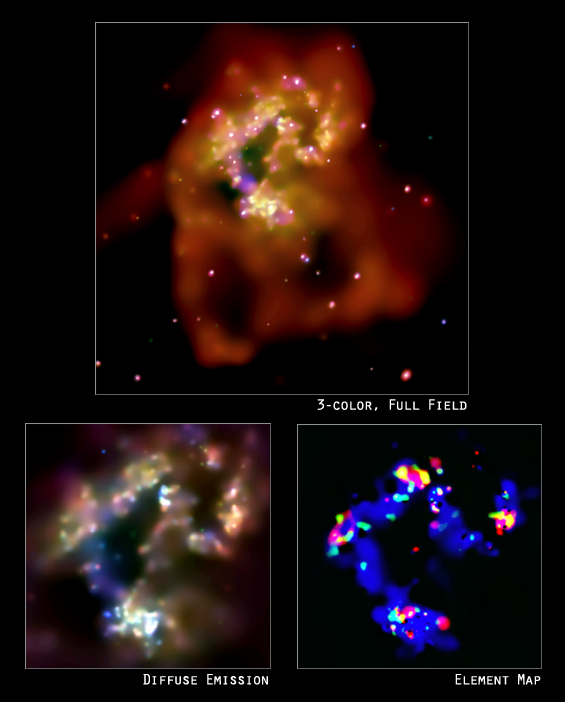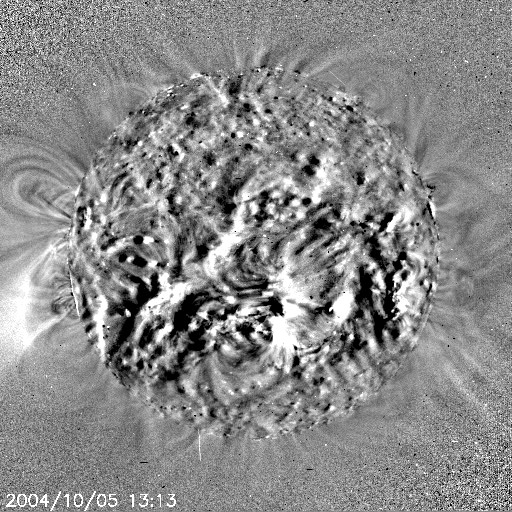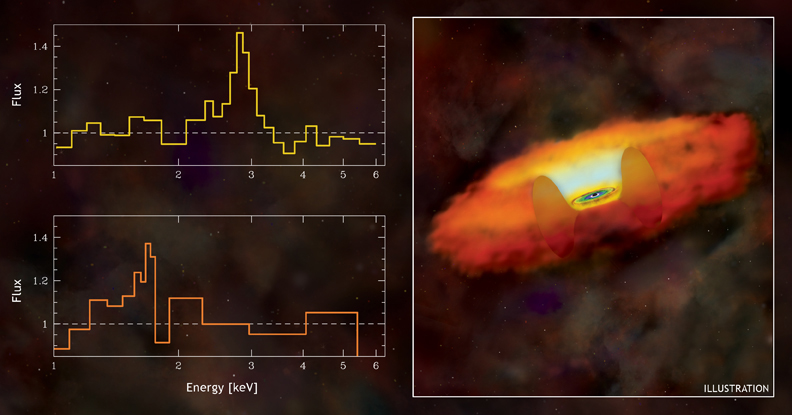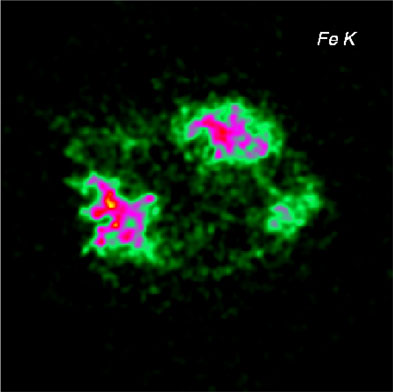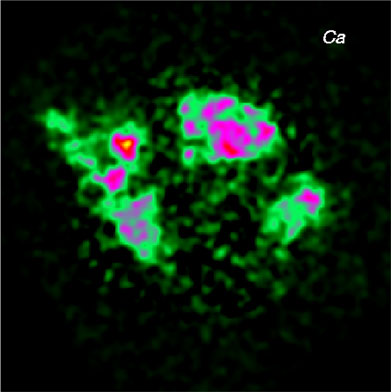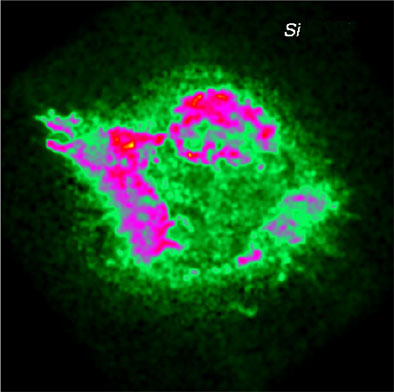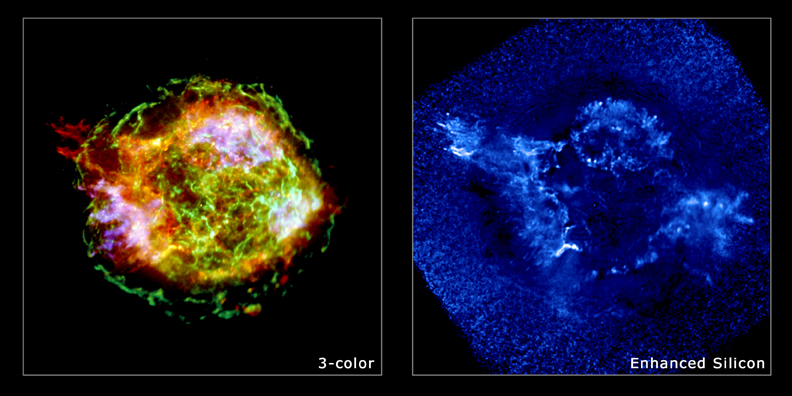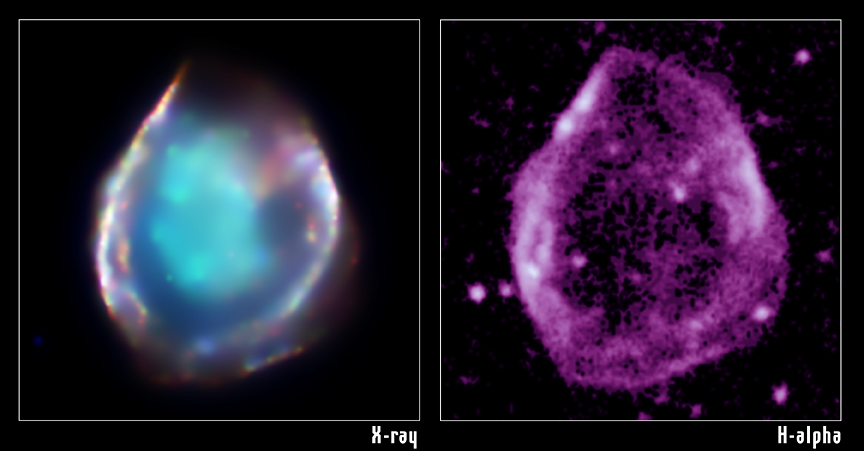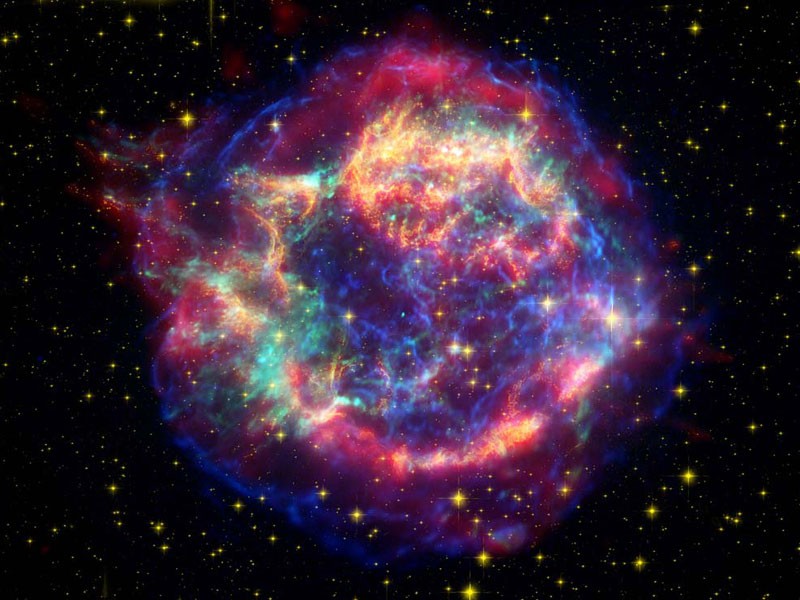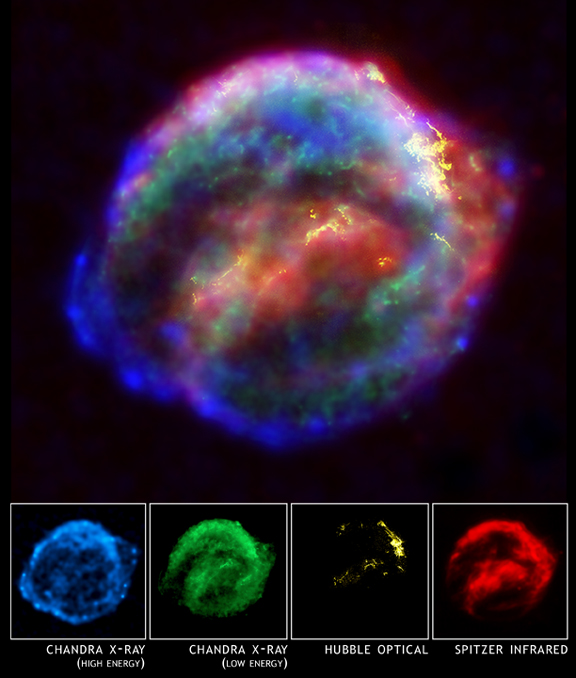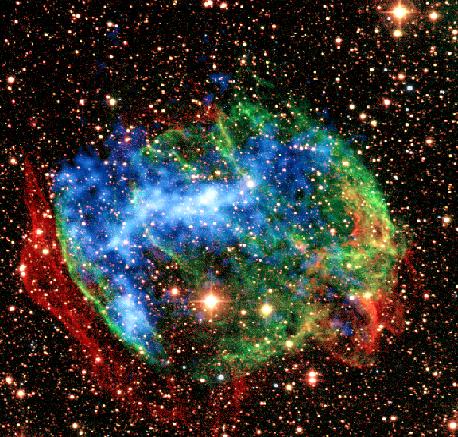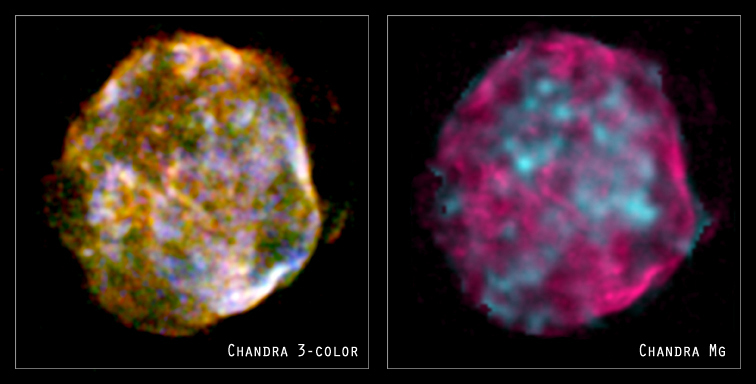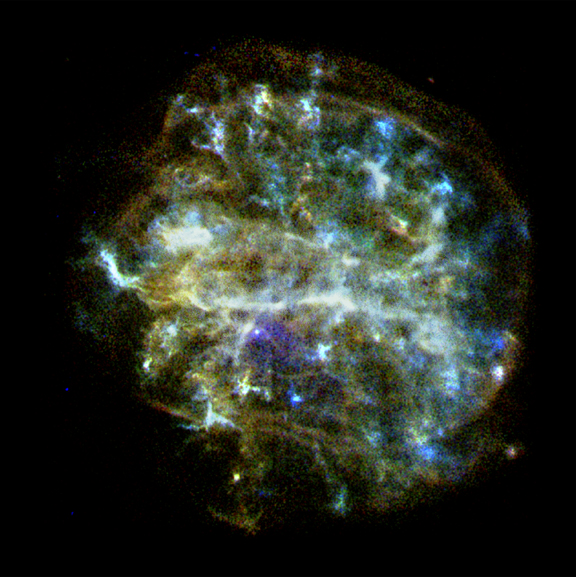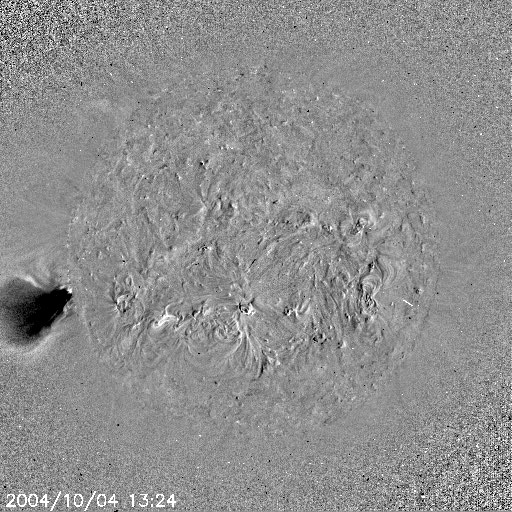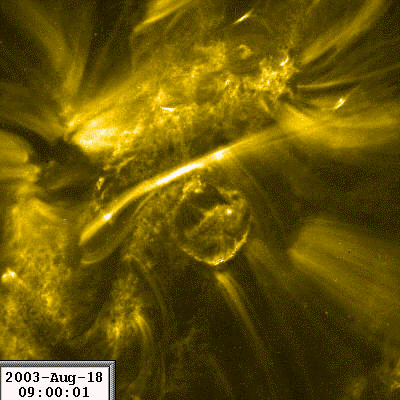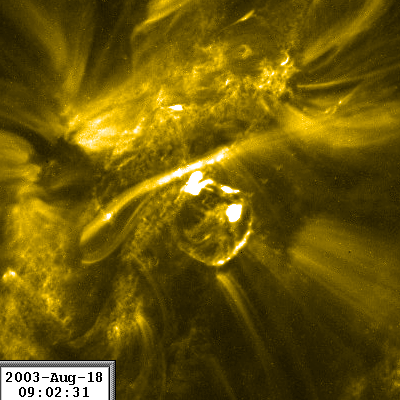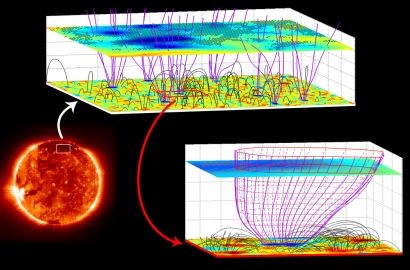|
Hubble's Satellite Evidence
NASA's Hubble Telescope rocks the very foundation of the gas
model
In The
Beginning
According to NASA, recent
Hubble
images suggest that silicon
and iron and neon and all the basic building blocks of the universe are ANCIENT compared to gas
model predictions. This unexpected abundance of iron in the early
universe was also recently
confirmed by the
Spitzer telescope as well. The discovery of this much iron in
the early universe, and the presence of such mature galactic structures at the
dawn of the universe, significantly undermines the
predictions and the usefulness of the gas model.
Quasars in the early
universe also show significantly higher iron concentrations than our own sun.
This early abundance of iron strikes at the very foundation of the notion that
the big bang began as an "explosive singularity". It suggests an
abundance of these heavier elements existed less than 1 billion years
after the big bang or big "slam" or big "bloom" like an organized lotus blossom
from a singularity. The presence of iron and silicon in the early universe certainly calls into question the
presumption that all matter originated from one singularity in one giant
explosion as gas model theories suggest.
The Big Bang may have never have been an explosive singularity at all. It
may have
simply been a collision of preexisting matter like a big "slam", not unlike a galaxy
collision where some areas interact at the center and some areas do not interact
as violently. It may have been more like a big
lotus blossom "bloom" from a highly organized singularity that released complete
galaxies intact. If either of these ideas turn out to be true, then we
would expect to see iron and silicon in the early stages of the formation of
this universe. That
seems to be exactly what has been revealed in the past few years thanks to Hubble and
its discovery of ancient iron and ancient silicon.
Iron and silicon are far more abundant in the early stages of the formation of
our universe than predicted by the gas model. This revelation lays the gas
model theories, and its key predictions to waste.
According to biological theories, the element of silicon is thought to be an alternative to carbon
in it's ability to form the foundation for intelligent life.
Recent evidence
from NASA's Spitzer Telescope suggest that hydrocarbons and all the basic
building blocks of intelligent life were in abundance from the earliest stages
of the universe. As far as we can tell, all of the elements that
support intelligent life have eternally existed and were present in the design
from the very beginning. There are very important and profound questions
that must be asked and must be answered based upon these new 21st century images
of our universe, especially in light of the abundance of the basic building
blocks of intelligent life as far back in time as Hubble and Spitzer can see.
Galaxy
Collisions
Chandra adds a new and impressive set of images to our investigation.
These images also call into question the predictions of the gas model.
Another devastating blow to the predictions of the gas model, and evidence
to support the solid surface model comes to us from
Harvard's analysis of
Chandra data.
As they watch two galaxies collide, they used spectral analysis to isolate
the most abundant elements released in these collisions. Not surprisingly
in a solid surface model of the sun, they
found large quantities of IRON (no doubt from ferrite), magnesium, silicon and neon.
The red/orange areas of the top photo represent the iron released in these
collisions. The bottom images isolate the silicon and neon elements
separately. Note that
every one of these elements is present in the data from the
SERTS program as well, and
the abundance of these specific elements fits perfectly with a solid surface
model.
You'll note that this evidence directly conflicts with the gas model since the gas
model theory insists that these colliding stars are iron poor. If that were true, then
the
elements produced in hydrogen gas ball collisions would necessarily be more
random in nature and would not contain such an abundance of very SPECIFIC
elements, the very same elements we find in our own sun.
According the gas model theories, these collisions should be relatively iron
poor interactions, and the elements created in these interactions should be more
random in nature. They certainly are NOT iron poor interactions. They contain large quantities
of very specific elements like iron, calcium, magnesium silicon, and neon, all of which should exist in
much smaller
quantities if the gas model was accurate. It makes little sense to believe
that "hydrogen balls" bump together randomly and mysteriously form massive amounts of the
specific elements of iron,
calcium, silicon and neon.
It makes a great deal more sense to believe that iron balls wrapped in calcium, silicon and neon
slamming into one another will release lots of iron, calcium, silicon and neon in the
ensuing chaos. One also wonders how gas model theorists intend to explain
the presence of THESE SPECIFIC elements, and ONLY these specific elements in
such great abundance from such chaotic interactions.
Some other tantalizing clues from
Harvard include
rather impressive ferrite ion clouds circling black holes. That
makes perfect sense in solid calcium ferrite surface model, since these clouds would be composed of the
crushed remnants of stars being swallowed by the black hole.
Chandra has also imaged iron, calcium and silicon layers in the supernova
remnants of Cassiopeia A. In these images we still find an expanding LAYER of
ferrite iron that is clearly spherical. This LAYER spans the width of this star
remnant, suggesting that this layer was a iron surface that is now spread out
as leftover remnants from the
supernova explosion. This iron emission activity is spread along
an entire surface and obvious significant concentrations can be seen at the two and eight o'clock
positions. It also sees an expanding LAYER of calcium, beneath an
expanding LAYER of silicon. This is
just like the arrangement of layers we see on our own sun. There are definite patterns of layers
emerging from the Chandra and Spitzer supernova data. Since it still had a ferrite
layer, a calcium layer, and a silicon layer, the explosion patterns we
see in this supernova remnant his explosions matches the predicted patterns of a
solid surface model. It is very difficult to explain such specific layers
in a hydrogen gas ball theory. Why these specific layers? How come they
formed such perfect spheres? Why is there an abundance of these specific
elements?
NASA's Chandra
found vast quantities of iron and silicon in the supernova remnants of DEM L71.
It reveals a hot inner cloud of glowing iron and silicon surrounded by an
outer blast wave. Again, this is entirely consistent with a solid
surface model that is rich in silicon and iron.
The Spitzer spacecraft just provided us with more evidence to support such an
idea. These images provide compelling evidence to suggest that our sun
has very specifically defined layers, namely ferrite, calcium and silicon.
Without enough neon, a star may simply overheat and go supernova.
Chandra has also witnessed ferrite ion emissions from the Capella binary system.
For a universe that is presumably iron poor, there sure are a lot of ferrite ion
emissions recorded in the Chandra data. Notice that the iron is not
located in the CENTER of these stars, but around the SURFACE of these stars, as
is the calcium as is the silicon. In other words we do NOT see a little
tiny speck in the center showing iron ferrite, but we see a whole SURFACE from
these images. That is certainly most visible in the silicon layer.
There is also
evidence in Keplar's supernova remnants to suggest the presence of iron,
silicon and neon from that exploding sun.
The
Math On Our Own Sun
Dr. Oliver Manuel's work on
lunar samples and comet analysis
also strongly suggests that our own
sun is mostly made of
iron as well as other very SPECIFIC elements. His body of work in the
field of nuclear chemistry is critically important and provides all
the math and analysis necessary to support this model fully.
Dr. Manual has put together a
very compelling case
through nuclear chemistry to demonstrate
that the sun is primarily composed of iron and other heavy elements. He
explains why the hydrogen model of the sun must be discarded based on a very
detailed analysis of lunar soil samples and comets. In recent months, many
of Dr. Manuel's conclusions about our sun being composed of material from a
supernova remnant
have been supported
by direct evidence. These visual results of an iron rich surface
have been predicted via the field of nuclear chemistry for more than three
decades!
Basic Methods To Demonstrate A
Ferrite Surface
Of The Sun Using SOHO Images
So now that we have all this evidence that suggests an abundance of silicon and
iron in the early universe, as well as evidence suggesting an abundance of iron
in our own sun, how might we apply this information and use this
information to locate the ferrite layer of our own sun?
There are several ways to demonstrate the sun's ferrite surface using
the raw EIT (marked DIT) images taken by SOHO.
One method relates to solar flares which occasionally "light up" the surface
during the flare's discharge. Just such a flare can be seen in the left
side of the first grey photo of this page. As it ignites, the surface can be seen
and some of the sun's surface features become visible.
Another method relates to a special type of image processing called a "running
difference" exposure. This
processing method resulted in a series of daily "snapshots" of the surface from
October 5th-15th, 2004 taken about the same time everyday, and
most recently at the end
of May through early
June of 2005. This processing method provides
us with an excellent opportunity to see the solid surface features of the sun MOVE from left to
right as the sun rotates.
Another method relates to matching up these flare snapshots and running
difference images at intervals of 27.3
days, and lining up surface features from a previous rotation. This
process can be somewhat problematic since flares are rather random in nature and
there is no guarantee there will be another flare snapshot that will conveniently
occur
exactly 27.3 days from the
first one. That idea also presupposes the notion that the surface of
the sun hasn't changed
much during that particular rotation cycle. Depending on the sun's activity,
and it's 11 year polar shift cycle, the
surface can change rather dynamically over any given rotation cycle. Since
the sun is fairly dynamic, and constantly changing over time, this method
requires a bit more patience and a bit more effort, and a whole lot of luck!
A more convincing method IMO involves the comparison of regularly timed "running
difference images" and noting the rotation of surface
features that move uniformly across the surface regardless of polar proximity.
These surface features are VERY consistent from one image to the next and rotate
from left to right very uniformly with the sun's rotation. That is only
possible if there is a solid and stable surface to create such long lasting
structures.
Perhaps the most impressive and fascinating video and photos that SOHO captures
relate to "Sunquakes". Surface fractures and sunquakes occur fairly often, both large and small.
These can result in absolutely massive coronal discharges. We were lucky enough
to catch a fairly massive quake on this side of the sun in January of 2005.
To me, this particular video evidence is the most revealing and compelling of all and was instrumental in
the
formation of these theories.
These sunquakes can even result in massive shock waves and solar tsunamis that traverse the
surface of the photosphere. These shock waves can actually be seen "crashing
into" surface features that are visible in surface "snapshots"
taken just after the
shockwave event. This happened quite dramatically on May 13th, 2005.
These images present a serious challenge to gas model theorists because contrary
to gas model expectations, these ferrite ions are coming from the WHOLE surface
of the sun, not simple a marble like "core" in the center of a giant ball of
gas. In contrast to gas model predictions, these images of a rigid ferrite
surface stick out like a giant sore thumb. Gas models all suggest that
only a little iron exists at the very core. If that were true, we should
only expect to see a marble sized "core" in the center, not an entire surface of
ferrite! These images suggest the entire sun is made of heavy metals, not
hydrogen. Hydrogen is simply the last layer of many layers that cover the
metallic sun. Calcium sits on the ferrite, silicon sits on the calcium.
If there is neon, it will sit on the silicon and light up the sky. If no
neon is present, you the sun is simply not "visible" to the naked eye.
Hydrogen and helium would simply be the "by products" of the electrical activity
of the ferrite surface. Hydrogen and helium are abundant only because of
the calcium ferrite emissions that are seen in BBSO images.
Basic Methods To Demonstrate A Surface
using TRACE images
SOHO is only one of two satellites that are capable of imaging the ferrite layer
of the sun. The first gold image on the right is a single snapshot
from a movie of this layer that was created
by the TRACE satellite using the same running difference imaging technique that
SOHO uses. The second and third gold photos on the right show close up
images of the ferrite layer of the sun. We can see the ferrite particles
streaming through the silicon in this photo, as well as a nice crater looking
object that remains consistent for over 2 and a half minutes, virtually an
eternity in solar terms.
The European Space Agency also announced a recent discovery by Eckart
Marsch and Chuanyi Tu that suggests that
solar wind originates in coronal funnels that begin just underneath the
surface of the visible photosphere. In fact their work lends a great deal
of support for the existence of an underlying ferrite layer that sits beneath the surface of the
neon photosphere. If we compare these moving funnels that ESA discovered with
BBSO images of the calcium layer, we can see that the base of
these funnels originate with the calcium ferrite interaction right near the
ferrite surface. It is the massive movement of ferrite particles within
the calcium layer that create these
tornado like coronal funnels.
Recent
Observations In The News
It seems that we still know very little about the actual composition of our sun.
Scientists have recently been surprised to find an abundance of neon in stars
and an abundance of neon in our our sun. While this abundance of neon
is certainly no surprise in a solid surface model, it demonstrates a relative
weakness in the gas model theories. These theories are based on a notion
of a solar composition that is based on photon counts found in spectral
analysis. I am simply amazed that some are suggesting that "neon atoms in
the sun give off no signatures in visible light". I find that fascinating
since neon plasma shines in virtually every office building in world in visible
light just fine, and there is ample evidence of electrical activity on the sun. | 